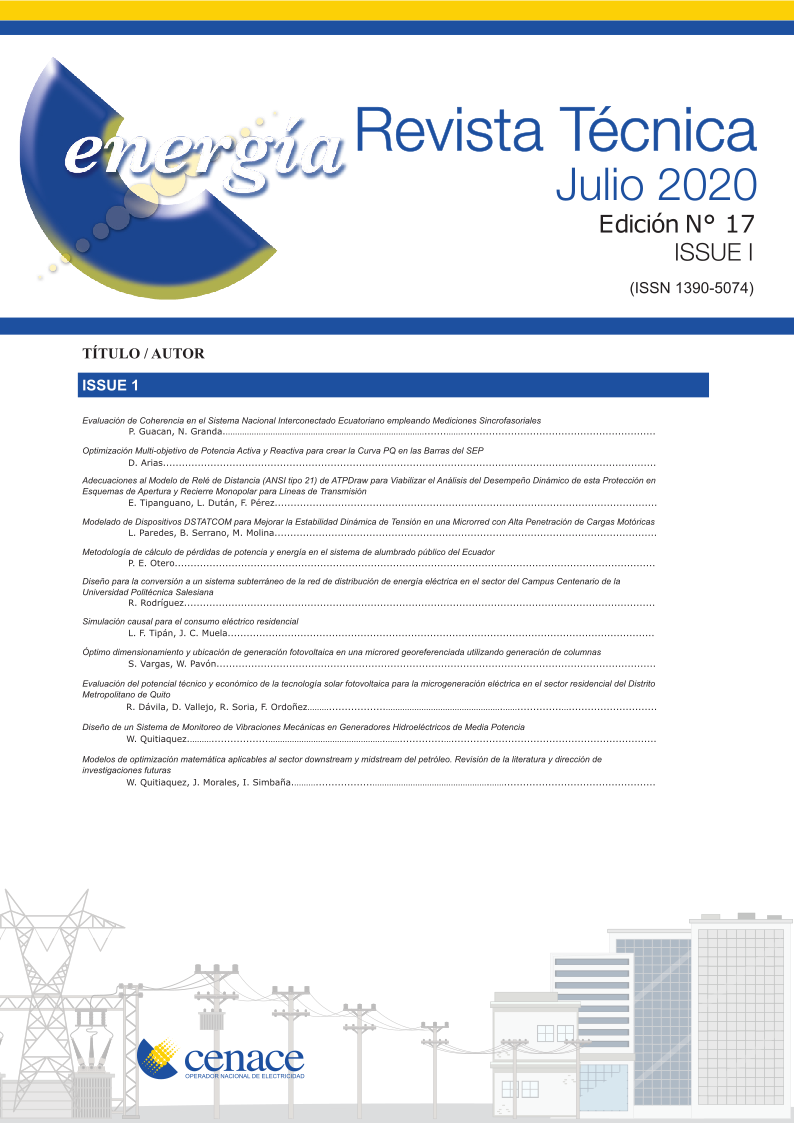Modeling of DSTATCOM Devices to Improve Dynamic Voltage Stability in a Microgrid with High Penetration of Motor Loads
Main Article Content
Abstract
This paper proposes and validates models of FACTS technology devices of the Synchronous Static Compensator for Distribution (DSTATCOM) type. In the first instance, a simplified DSTATCOM modeling performed through a controlled current source is presented. Subsequently, a DSTATCOM modeled through control strategies is exposed considering a PWM (Pulse-Width Modulation) converter. The proposed models of DSTATCOM devices are validated in a CIGRÉ Electrical Microgrid (MG) test system. The presence of induction motor type loads in the MG requires a considerable demand for reactive power, this causes inconveniences to maintain the Dynamic Voltage Stability (DVE). This situation is aggravated by the occurrence of failures that trigger an isolated operation of the MG. To solve these problems, a DSTATCOM device will be used. The optimal connection and location of DSTATCOM in the MG is done through an exhaustive search algorithm, considering the premise of the best performance in terms of DVE made through dynamic simulations in PowerFactory DIgSILENT. Comparatively, the results obtained for the two models performed are presented, showing the improvement of the DVE in the isolated operation of the MG with both models. Depending on the detail and scope of the studies in the MG system, you can choose between the developed DSTATCOM models. All details of models, control diagrams and data of DSTATCOM devices are provided in this document.
Downloads
Article Details
Aviso de Derechos de Autor
La Revista Técnica "energía" está bajo licencia internacional Creative Commons Reconocimiento-NoComercial 4.0.
References
[2] L. A. Paredes, B. R. Serrano, and M. G. Molina, “Microgrids ─ a Methodological Review in the Current Context of Electric Systems,” CIEEPI - Rev. del Col. Ing. Eléctricos y Electrónicos Pichincha, no. 49, 2019.
[3] K. P. Schneider, F. K. Tuffner, M. A. Elizondo, C. C. Liu, Y. Xu, and D. Ton, “Evaluating the Feasibility to Use Microgrids as a Resiliency Resource,” IEEE Trans. Smart Grid, vol. 8, no. 2, pp. 687–696, 2017.
[4] D. E. Olivares et al., “Trends in microgrid control,” IEEE Trans. Smart Grid, vol. 5, no. 4, pp. 1905–1919, 2014.
[5] J. Guerrero et al., “Distributed generation: Toward a new energy paradigm,” IEEE Ind. Electron. Mag., vol. 4, no. 1, pp. 52–64, 2010.
[6] L. A. Paredes, B. R. Serrano, and M. G. Molina, “Energy Management in Isolated Microgrids of the Ecuadorian Amazon Region,” in 3er Simposio Ibero-Americano en Microrredes Inteligentes con Integración de Energías Renovables, 2019.
[7] F. Katiraei, M. R. Iravani, and P. W. Lehn, “Micro-grid autonomous operation during and subsequent to islanding process,” IEEE Trans. Power Deliv., vol. 20, no. 1, pp. 248–257, 2005.
[8] IEEE PES Industry Technical Support Task Force, “Impact of IEEE 1547 Standard on Smart Inverters,” 2018.
[9] A. Khadem Abbasi, M. W. B. Muatafa, and A. S. B. Mokhtar, “Small signal stability analysis of rectifier-inverter fed induction motor drive for microgrid applications,” IEEE Reg. 10 Annu. Int. Conf. Proceedings/TENCON, pp. 1015–1019, 2011.
[10] D. Wu, H. Wu, and H. Dongt, “Influence of induction motor starting on microgrid,” Asia-Pacific Power Energy Eng. Conf. APPEEC, vol. 2018-Octob, pp. 376–381, 2018.
[11] N. Afrin, F. Yang, J. Lu, and M. Islam, “Impact of induction motor load on the dynamic voltage stability of microgrid,” ANZCC 2018 - 2018 Aust. New Zeal. Control Conf., pp. 397–402, 2018.
[12] W. Freitas, A. Morelato, W. Xu, and F. Sato, “Impacts of AC generators and DSTATCOM devices on the dynamic performance of distribution systems,” IEEE Trans. Power Deliv., vol. 20, no. 2 II, pp. 1493–1501, 2005.
[13] T. Samad and A. M. Annaswamy, “Controls for Smart Grids: Architectures and Applications,” Proc. IEEE, vol. 105, no. 11, pp. 2244–2261, 2017.
[14] L. A. Paredes, B. R. Serrano, and M. G. Molina, “Nuevo Paradigma de los Sistemas Eléctricos: Generación Distribuida y Microrredes Eléctricas un Vínculo de Accesibilidad a la Electricidad en América Latina y el Caribe,” ENERLAC, vol. 3, 2020.
[15] M. S. Mahmoud and F. M. AL-Sunni, Control and Optimization of Distributed Generation Systems. 2015.
[16] G. B. Gharehpetian and S. M. M. Agah, Distributed Generation Systems: Design, Opearation and Grid Integration. 2017.
[17] E. A. Tapia, J. D. Pinzón, and D. G. Colomé, “Load Dynamic Impact on Short-Term Voltage Stability,” in 2019 FISE-IEEE/CIGRE Conference - Living the energy Transition (FISE/CIGRE), 2019.
[18] A. A. Edris et al., “Proposed terms and definitions for Flexible AC Transmission System (FACTS),” IEEE Trans. Power Deliv., vol. 12, no. 4, pp. 1848–1853, 1997.
[19] L. Gyugyi, R. A. Otto, and T. H. Putman, “Principles and applications of static, thyristor-controlled shunt compensators,” IEEE Trans. Power Appar. Syst., vol. PAS-97, no. 5, pp. 1935–1945, 1978.
[20] N. G. Hingoranl, L. Gyugyi, and M. E. El-Hawary, Understanding FACTS: Concepts and technology of flexible ac transmission systems. 1999.
[21] L. A. Paredes, B. R. Serrano, and M. G. Molina, “FACTS Technology to Improve the Operation of Resilient Microgrids,” in 2019 FISE-IEEE/CIGRE Conference - Living the Energy Transition (FISE/CIGRE), 2019, pp. 1–7.
[22] F. M. Gonzalez-Longatt and J. L. Rueda, PowerFactory Aplications for Power System Analysis. Springer, 2014.
[23] S. Houbing, S. Ravi, S. Tmim, and J. Sabina, Smart Cities, no. 10. Wiley, 2017.
[24] L. A. Paredes, B. R. Serrano, and M. G. Molina, “Voltage Stability Improvement with a DSTATCOM in a Microgrid Integrated by DG Solar Photovoltaic and Conventional,” Rev. Técnica “energía,” vol. 16, no. II, 2020.
[25] R. B. Prada, “Voltage stability and thermal limit: Constraints on the maximum loading of electrical energy distribution feeders,” IEE Proc. - Gener. Transm. Distrib., vol. 145, no. ii, pp. 573–577, 1998.
[26] P. Coelho, M. Gomes, and C. Moreira, Microgrids Design and Implementation. 2019.
[27] Y. Xu, C.-C. Liu, K. Schneider, F. Tuffner, and D. Ton, “Microgrids for Service Restoration to Critical Load in a Resilient Distribution System,” IEEE Trans. Smart Grid, vol. 9, no. 1, pp. 1–1, 2016.
[28] J. Hossain and H. R. Pota, Robust Control for Grid Voltage Stability: High Penetration of Renewable Energy. 2014.




